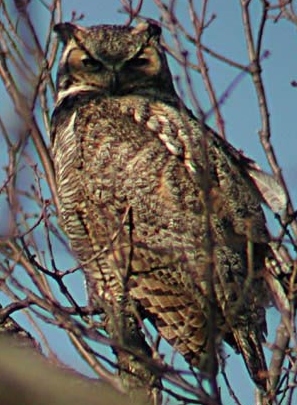|

Large owl with dark
brown, gray-brown mottled upperparts and dark barred underparts. Head
has distinct ear tufts and rufous facial disk. Throat and
upper breast are white and may have dark spots. Northern birds are paler
and grayer. Strong, silent, direct,
flap and glide flight.
|
GREAT
HORNED OWL
Bubo virginianus
STRIGIFORMES
True Owls (Strigidae)
Range and Habitat
Great Horned Owl: Found throughout the forests of North,
Central, and South America, from the Arctic to the Straits of Magellan.
Preferred habitats include coniferous, mixed, and deciduous woodlands,
areas along cliffs and rocky canyons, and forest openings.
SOUND: "whoo! Whoo-whoo-Whoo! Whoo! Whoo!", "hoot-hoot-hoot-hoot"
The Great Horned Owl will eat birds ranging in size from kinglets to
Great Blue Herons and regularly eat other owls.
The reintroduction of Peregrine Falcons has been hampered in some areas
by owls killing both adult and nestling falcons.
In frigid areas, where larger prey cannot be eaten quickly,
they may let uneaten food freeze and then thaw it out later
using their own body heat.
A group of owls has many collective nouns, including a "bazaar",
"glaring", "parliament", "stooping", and
"wisdom" of owls.
The Great Horned Owl is native to and the most widespread owl species
throughout the Americas. Its breeding grounds are found in subarctic
areas of North America, Central America and South America. Their preferred
habitats include deciduous, coniferous and mixed woodlands, tropical
rainforests, prairies, deserts, urban areas and mountains.
Once this bird finds a mate, it becomes a permanent resident in its
territory. Great Horned Owl eggs and young may fall prey to foxes, coyotes
and wild or feral cats. Their diets consist of mammals such as rabbits,
rats, squirrels, mice, moles, voles, shrews, bats, weasels and gerbils.

|